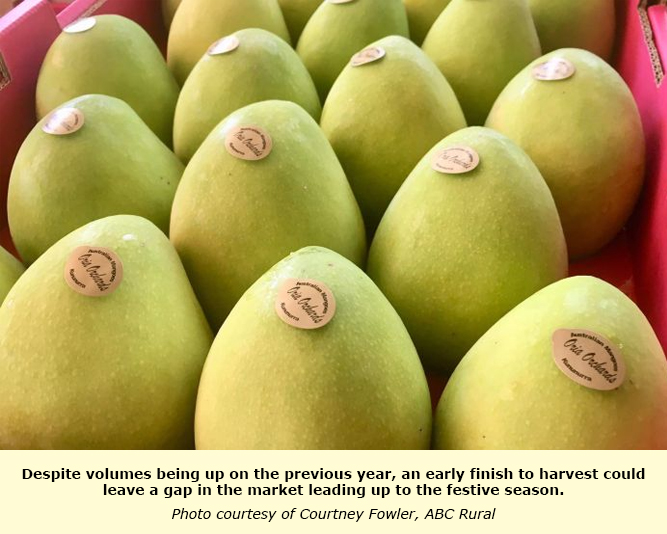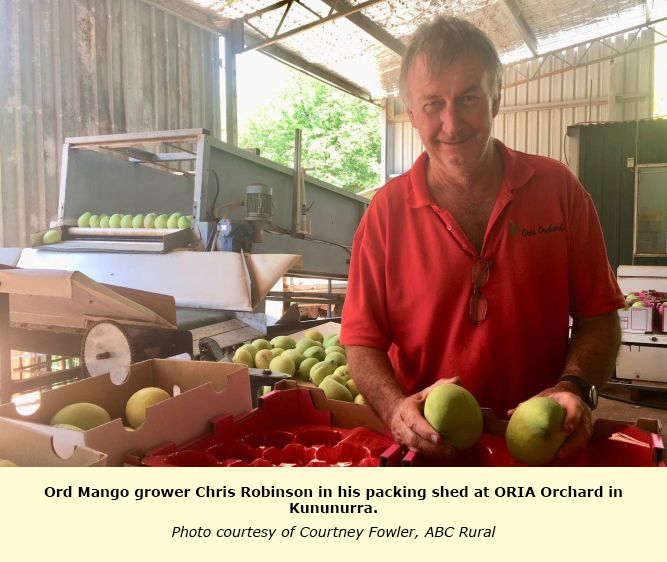An early finish to the Kimberley and Northern Territory mango seasons could see a shortage of mangoes on shelves in Western Australia (WA) this Christmas.
The mango harvest in WA’s Ord Irrigation Scheme wrapped up almost three weeks early, coinciding with an early finish for Katherine growers and some Darwin orchards as well.
Adrian Farcic, of fruit and vegetable wholesaler Mercer Mooney at the Canning Vale market in Perth, said despite volumes being up on the previous year, an early finish to harvest could leave a gap in the market leading up to the festive season.
“In the next couple of weeks, we will be finished with Kununurra mangoes and Territory mangoes,” he said.
“It’s actually looking like there might not be much around at Christmas but that’s without knowing what’s happening with the Calypsos.
“Calypso mangoes are starting but we don’t handle them as they’re an exclusive variety [and] I’m not 100 per cent sure they’ll last until Christmas.”

New mangoes for New Year
Mr Farcic said WA consumers would not be without mangoes for long this summer, with plenty of good quality fruit expected to come from Carnarvon growers by the New Year.
“By all accounts there’s some nice fruit up there and quite a bit to come down in comparison to usual years,” he said.
“It’s still early days but the quality is improving year on year, now that a few more growers are putting more focus into their mangoes.”
Mr Farcic said despite a shorter growing season, the Kimberley yielded volumes which had not been seen in five years.
“By the time it all wraps up we would have seen around 600,000–700,000 trays out of Kununurra,” he said.
“Probably about five or six years ago there was bigger numbers coming through but considering the previous year, this is definitely an above average season.”
Mr Farcic added that quality had been exceptional from smaller growers in the Ord and first grade fruit had been fetching good prices.
“As much as the small growers might not have a huge amount of volume, their quality was definitely really good,” he said.
“The eating quality in Kununurra is probably some of the best around.”
Best quality fruit in years
Ord River Mango Growers Association member Chris Robinson is packing his last trays of Kensington Prides at ORIA Orchard this week.
He said the quality of fruit coming out of the region was the best he had seen in years.
“We’re only a small producer in the Ord but we’ve had a reasonably good season and we’ve had some incredibly good quality fruit,” he said.
“It’s a pleasure to pack nice fruit and I think because the fruit is so good it will end up in some of the gourmet fruit and veg shops in Perth.”
Mr Robinson attributed increasing yields to increased tree health following a strong wet season.
“We’ve just come out of six years of really horrible yields and horrible seasons, so a lot of the tree health was really poor but the last two years the tree health has improved,” he said.
“A lot of trees around the Valley look far better now than they ever have done.
“I predicted this year would be a fair bit better than what it is in terms of yields and we had the potential.
“If you look around at some of the growers they certainly got those yields and last year’s wet season indicated that we should have had a good season this year.”
And while many smaller growers like Chris Robinson did not experience the bumper crop expected after the wet, one large scale producer in the Valley had its best season yet.

Growers hopeful of a return to normal yields
Toni Gelati’s Galango orchard has reportedly doubled production under new management this season after it was leased out by Darwin growers earlier this year.
“Some people have had a really good [yielding] season, others have had quite poor seasons so it’s been a bit of a mixed bag,” Mr Robinson, said.
“I think Galengo orchard has put out probably more than double the fruit that’s ever put out before.
“I gather a lot of that fruit is going over east, so it’s not flooding the Perth market.”
Mr Robinson said he hoped another strong wet season would set mango growers in the Ord up for a return to normal size yields again.
“We traditionally pack for about six to eight weeks a year and this year we’re down to about four or five weeks, so we’re about 2 or 3 weeks shorter than most years,” he said.
“Let’s hope we get another good wet season like last year and that should set us up for a good crop next year.
“I think if we get back up to volume we can start doing some export marketing and other sorts of marketing and not just rely on the Perth market.”
Written by Courtney Fowler
Source: ABC Rural
